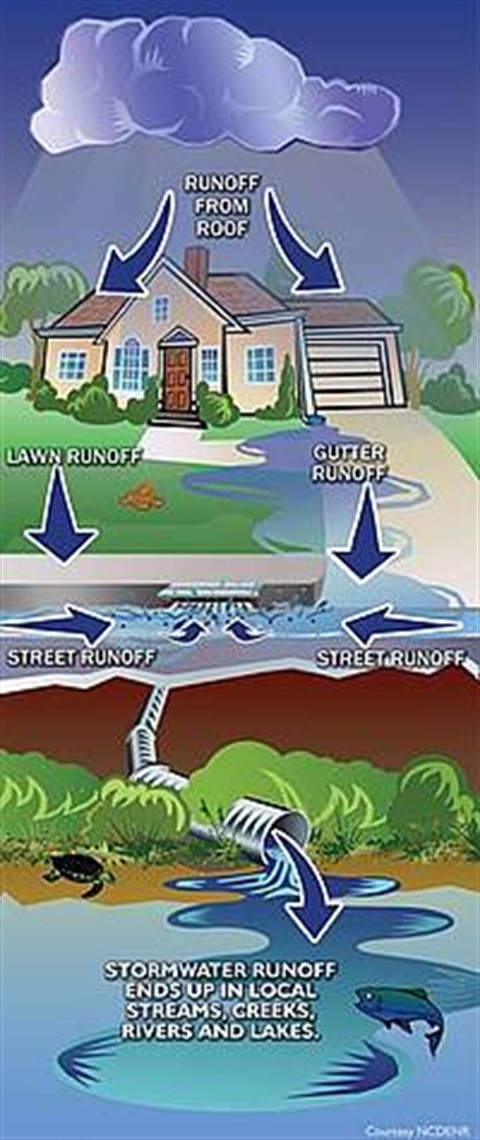Storm Water Pollution Prevention

General Permit
In 2004, the Town of Manchester developed a townwide Stormwater Management Plan. This plan is a required component of the Connecticut Department of Energy & Environmental Protection (CTDEEP, formerly known as DEP) General Permit for the Discharge of Stormwater from Small Municipal Separate Storm Sewer Systems, more commonly known as the "MS4" permit. The goal of the MS4 permit program is to improve overall water quality by reducing the amount and potential for pollutants to enter our water system.
The Stormwater Management Plan identifies measurable goals in each of the following six control measures:
- Public Education and Outreach
- Public Participation and Involvement
- Illicit Discharge Detection and Elimination
- Construction Site Runoff Control
- Post-Construction Runoff Control and
- Pollution Prevention/Good Housekeeping
The overall purpose of the program is to protect the quality of our natural resources by reducing the discharge of pollutants to wetlands and watercourses.
Annual Reporting
CTDEEP requires that towns annually submit reports documenting their progress towards achieving the goals for each control measure that were originally identified in the 2004 Stormwater Management Plan(PDF, 376KB). They also require that towns sample and test stormwater runoff from predetermined representative locations and submit the results to CTDEEP.
View the draft 2024 Annual Report here(PDF, 199KB). Submit any comments on this draft to pwinfo@manchesterct.gov.
The Town has made considerable progress towards the goals originally identified in the 2004 Plan, as documented below in the annual reports submitted to CTDEEP:
2020 Annual Report(PDF, 237KB)
2021-22 Annual Report(PDF, 246KB)
2023 Annual Report(PDF, 202KB)
2020 Manchester MS4 Map(PDF, 4MB)
Directly Connected Impervious Areas Map (DCIA)(PDF, 2MB)
2024 Basin Priority Rankings Map(PDF, 452KB)
If you have any comments regarding this plan or annual report, please contact Jeff LaMalva, Town Engineer at (860) 647-3158 or via email.
Best Management Practices
The MS4 permit mentioned above contain Best Management Practices (or BMP's) for the Town's operations. Reducing the amount of pollutants entering our watercourses is important because it affects plants, fish, animals and people. After it rains, stormwater runoff can pick up chemicals, debris, sediment and other pollutants from the ground as it flows untreated into the water bodies we use for recreation purposes and sources of our drinking water. Everyone can play a part in reducing these pollutants from entering our water bodies.
Below are some brochures and links that show ways you can help.
Education
U.S. Environmental Protection Agency National Pollutant Discharge Elimination System (EPA NPDES) provides more information on MS4 programs at the federal level. For more information see: EPA NPDES Webpage
For a glossary on terms used on this page and throughout those linked and to learn more, see Water Cycle Glossary (Thanks Jenae!)
To learn more, see the following links:
- The Water Cycle, Cloud Formations and Rainbows Explained (Thanks Megan!)
- Water Pollution: How Humans Impact the Water Cycle (Thanks Amelia!)
- Protecting Water Quality from Urban Runoff(PDF, 231KB)
- Think Green, Stay Blue: Clean Water Starts with You!(PDF, 217KB)
- Stormwater Pollution Prevention Guide for Homeowners(PDF, 676KB)
- Disconnecting Impervious Areas at Home: Driveways(PDF, 3MB)
- Disconnecting Impervious Areas at Home: Rooftops(PDF, 4MB)
- Reduce Stormwater Pollution: Pet Waste(PDF, 500KB)
- Clean Water Campaign Pet Waste Poster(PDF, 232KB)
- Nonpoint Source Water Pollution(PDF, 66KB)
- Stormwater Information Brochure(PDF, 2MB)
- Impacts of Development on Waterways(PDF, 635KB)
- Reduce the Need for Pesticides and Herbicides(PDF, 2MB)
- Organic Fertilizer Fact Sheet(PDF, 1MB)
Residential Low Impact Development
Low Impact Development (LID) is an ecologically based stormwater and land use management approach which favors management of rainfall on site through a mostly vegetated treatment network. The goal of LID is to mimic natural hydrologic conditions by using techniques that infiltrate, filter, store, and evaporate stormwater runoff close to it's source. To learn more about helping at home see Residential Best Management Practices(PDF, 740KB) and the Sustainable Design and Low Impact Development Guidelines(PDF, 2MB).
The following links provide additional information on some of the treatments mentioned in the Guidelines:
If you see illegal dumping into storm drains, please call (860) 647-3067 or (860) 647-5235.
Help keep our water clean.